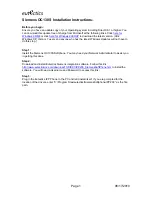
sc->irq = 3;
3
sc->iobase = 0;
4
sc->ispcmcia = 1;
5
sc->cinfop =card_infop;
pcmcia_register_event_callback(card_infop->socket_vnum,
6
CARD_REMOVAL_EVENT,
(caddr_t)el_card_remove,
(caddr_t)sc);
if (multi_func_flag)
7
lan_set_attribute(sc->ehm.current_val, NET_MODEL_NDX, "3C562");
else
lan_set_attribute(sc->ehm.current_val, NET_MODEL_NDX, "3C589");
break;
case BUS_ISA:
8
sc->irq = irq_sel.channel;
9
sc->isa_tag = isatag;
10
sc->iobase = ((reg-0x200)/0x10)&0x1f;
11
lan_set_attribute(sc->ehm.current_val, NET_MODEL_NDX, "3C509");
12
break;
}
1
Evaluates the
bus_type
member of the
bus
data structure for this
3Com 3C5x9 device.
2
Performs tasks that are related to the PCMCIA bus if
bus_type
evaluates to
BUS_PCMCIA
.
3
Sets the interrupt request (IRQ) to the value 3.
4
Sets the I/O base of the program card to the value 0 (zero).
5
Indicates that this is a PCMCIA unit and saves the card information
pointer.
6
Calls the
pcmcia_register_event_callback( )
routine. See the
if_el
source file (in the examples directory that is installed with the
device driver kit) for a listing of this routine.
7
Sets the model identification attribute for enhanced hardware
management support.
8
Performs tasks that are related to the ISA bus.
9
Saves the interrupt request (IRQ) from the ISA bus configuration code.
10
Saves the tag from the activation process.
11
Computes the I/O base to give to the device.
12
Sets the model identification attribute for enhanced hardware
management support.
Implementing the Autoconfiguration Support Section (probe) 5–9
















































